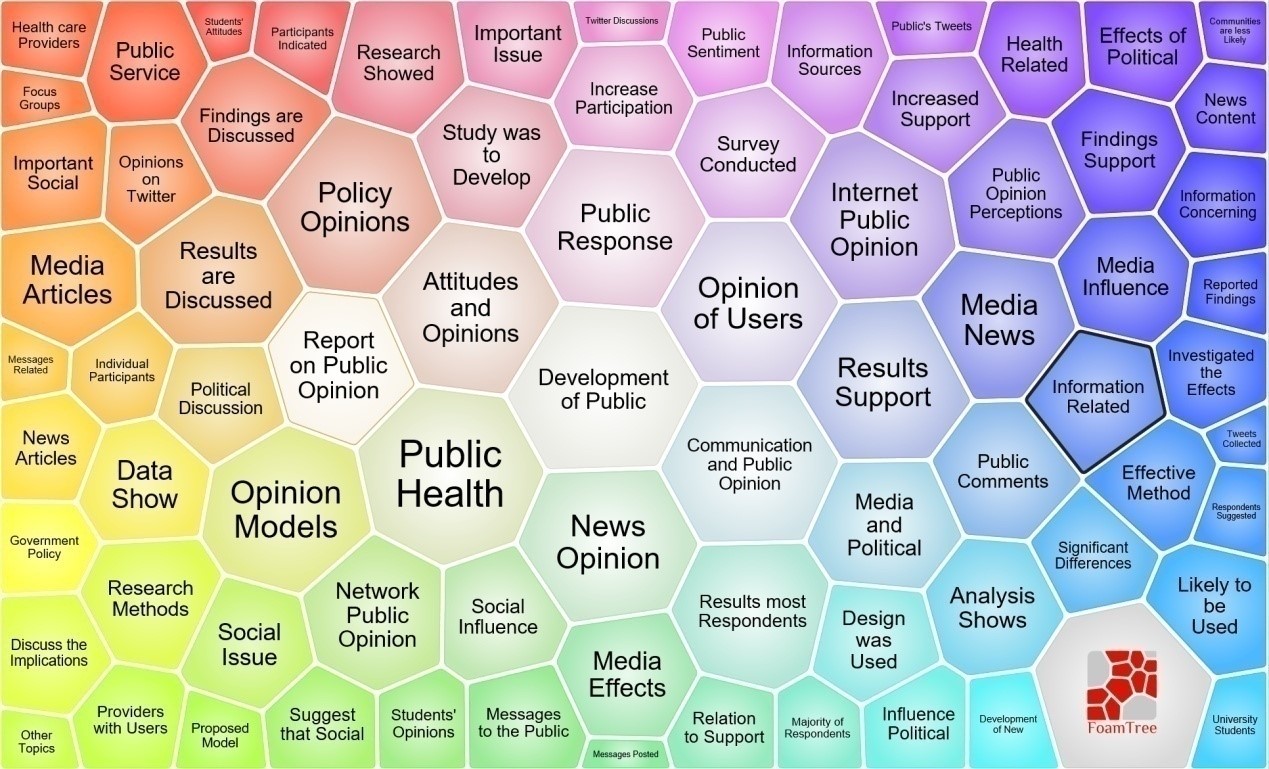 PDF(3982 KB)
PDF(3982 KB)


 PDF(3982 KB)
PDF(3982 KB)
 PDF(3982 KB)
PDF(3982 KB)
基于知识图谱的国外网络舆论研究的可视化分析
Visualization Analysis of Research on Foreign Network Public Opinion Based on Mapping Knowledge Domains
[目的/意义] 旨在全景式认知国外网络舆论研究的状况,为国内网络舆论研究和网络舆论治理实践奠定重要基础。[方法/过程] 以Web of Science数据库中近17年来国外网络舆论研究的期刊论文为研究对象,运用Cite Space V可视化知识网络分析工具和文献计量法,定量分析国外网络舆论的研究现状、研究基础和研究热点等。[结果/结论] 研究发现:近17年来,国外网络舆论研究呈现稳步上升趋势,呈现多学科交叉趋势,地域合作广泛;研究基础聚焦在舆论的“前因”(议程设置、框架分析)、大众舆论的形成“过程”(沉默的螺旋、RAS模型)、网络舆论的“后果”(政治参与、政府信任)等方面;研究热点为网络舆论的影响因素、网络舆论的监测分析、网络舆论对公众网络政治参与的影响。最后,基于国外网络舆论的研究给出国内网络舆论研究的建议。
[Purpose/significance] To realize a panoramic view of the status of foreign network public opinion research, and to lay an important foundation for the domestic network public opinion research and network public opinion governance practice. [Method/process] Based on Web of Science database, taking the foreign research literature related the network public opinion in recent 17 years as the sample, this paper applies the bibliometrics method and Cite Space V, a visualized knowledge network analysis tool, to make an in-depth exploration of the current situation, research base, hot topics, etc. of foreign studies on network public opinion. [Result/conclusion] The results show: during the past seventeen years, the number of academic papers on network public opinion is mainly characterized by a sharp upward trend; the research foundation focuses on the “antecedents” of public opinion (agenda setting, framework analysis), the formation of public opinion “process” (silent spiral, RAS model), and the “consequences” of network public opinion (political participation, government trust); hot topics include the determinants of online public opinion, monitoring and analysis of online public opinion, and the influence of online public opinion on public political participation. Finally, based on the foreign research of public opinion, this paper gives some suggestions to study online public opinion.

network public opinion / research base / bibliometric analysis / visualization analysis
| [1] |
喻国明. 当前社会舆情的结构性特点与分析性发现基于2014年中国社会网络舆情的大数据分析[J]. 江淮论坛, 2015(5): 136-143.
|
| [2] |
刘锐. 地方重大舆情危机特征及干预效果影响因素——基于2003年以来110起地方政府重大舆情危机的实证分析[J]. 情报杂志, 2015(6): 93-99.
|
| [3] |
刘焕. 公共事件网络舆情偏差及影响因素研究述评[J]. 情报杂志, 2018, 37(11): 96-102.
|
| [4] |
陈潭. 草根问政崛起后的舆情生态[J]. 人民论坛, 2012(24): 60-61.
|
| [5] |
CHEN C. Searching for intellectual turning points: progressive knowledge domain visualization[J]. Proceedings of the National Academy of Sciences, 2004, 101 (S1): 5303-5310.
|
| [6] |
MCCOMB M E, SHAW D L. The agenda-setting function of mass media[J]. The public opinion quarterly, 1972, 36(2): 176-187.
|
| [7] |
NOELLE-NEUMANN E. The spiral of silence: a theory of public opinion[J]. Journal of communication, 1974, 24(2): 43-51.
|
| [8] |
ENTMAN R M. Framing: toward clarification of a fractured paradigm[J]. Journal of communication, 1993, 43(4): 51-58.
|
| [9] |
MUTZ D C. Hearing the other side: deliberative versus participatory democracy[M]. New York: Cambrige University, 2006.
|
| [10] |
ZALLER J R. The nature and origins of mass opinion [M]. New York: Cambridge University Press, 1992.
|
| [11] |
IYENGAR S, HAHN K S. Red media, blue media: evidence of ideological selectivity in media use[J]. Journal of communication, 2009, 59(1): 19-39.
|
| [12] |
WOICIESZAK M E, MUTZ D C. Online groups and political discourse: do online discussion spaces facilitate exposure to political disagreement?[J]. Journal of communication, 2009, 59(1): 40-56.
|
| [13] |
HAN J K, LEE S, MCCOMBS M. The attribute agenda-setting influence of online community on online newscast: investigating the South Korean Sewol ferry tragedy[J]. Asian journal of communication, 2017, 27(6): 601-614.
|
| [14] |
SON Y J. Another look at what moves public opinion: media agenda setting and polls in the 2000 U.S. election[J]. International journal of public opinion research, 2006, 18(2): 174-197.
|
| [15] |
CHONG D, DRUCKMAN J N. Framing theory[J]. Annual review of political science, 2007, 10(1): 103-126.
|
| [16] |
SHAH D V, CHO J, EVELAND W P, et al. Information and expression in a digital age[J]. Communication research, 2016, 32(5): 531-565.
|
| [17] |
CROPF R. The virtual public sphere[J]. New media & society, 2009, 4(1): 9-27.
|
| [18] |
MUTZ D, MARTIN P. Facilitating communication across lines of political difference: the role of mass media[J]. American political science review, 2001, 95(1): 97-114.
|
| [19] |
IM T, CHO W, PORUMBESCU G, et al. Internet, trust in government, and citizen compliance[J]. Journal of public administration research and theory, 2014, 24(3): 741-763.
|
| [20] |
CERON A, NEGRI F. The "Social Side" of public policy: monitoring online public opinion and its mobilization during the policy cycle[J]. Policy and Internet, 2016, 8(2): 131-147.
|
| [21] |
METZGER M J, DOCTER S. Public opinion and policy initiatives for online privacy protection[J]. Journal of broadcasting & electronic media, 2003, 43(3): 350-374.
|
| [22] |
LUOMA-AHO V, VOS M. Monitoring the complexities: nuclear power and public opinion[J]. Public relations review, 2009, 35(2): 120-122.
|
| [23] |
TARUSIN M A, FEDOROV V V. Public opinion monitoring of the State of the Russian society[J]. Economic and social changes trends forecast, 2016, 3(45): 37-43.
|
| [24] |
BAUR A W. Harnessing the social web to enhance insights into people's opinions in business, government and public administration[J]. Information systems frontiers, 2017, 19(2): 231-251.
|
| [25] |
STIEGLITZ S, LI D. Social media and political communication: a social media analytics framework[J]. Social network analysis and mining, 2013, 3(4): 1277-1291.
|
| [26] |
NERESINI F, LORENZET A. Can media monitoring be a proxy for public opinion about technoscientific controversies? The case of the Italian public debate on nuclear power[J]. Public understanding of science, 2016, 25(2): 171-185.
|
/
| 〈 |
|
〉 |